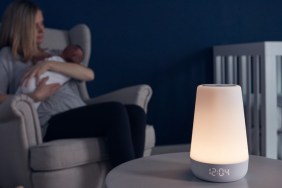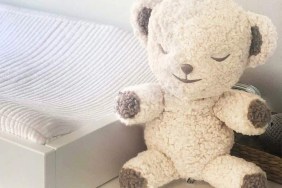Every time I see a leap approaching on my The Wonder Weeks app, I start to stress a little. Luckily, my son loves the SNOO, so while he will be a lot more fussy during his leaps, his sleep won’t suffer (knock on wood!). Unfortunately, he will soon be outgrowing the SNOO and sleep regressions don’t end at six months. Given that I can largely credit my son sleeping through the night as of six weeks to pediatrician Dr. Harvey Karp, CEO of Happiest Baby, I couldn’t think of a better person to speak to about sleep regressions and what we can do about them.
Momtastic: What is sleep regression and why does it happen?
Dr. Harvey Karp: You may think your little one is sleeping through the night, but babies never do that, nor do adults! We all get into very light sleep, or even wake up two to three times a night. Most of the time we don’t wake fully, unless something is wrong (you smell smoke, hear a noise, etc). and with babies, they also usually fall right back into another cycle of sleep, unless something is bugging them. Sometimes this is from increased hunger, related to a growth spurt, or a little discomfort like gas, a stuffy nose (a cold or dry air), or teething.
Sometimes, however, babies start waking more because they are sort of…bored. They suddenly start getting up every two to three hours, like a little baby, hence the name sleep regression. When they get into light sleep they want to play a bit or have some company.
Momtastic: When can parents expect sleep regressions?
Dr. Harvey Karp: Parents can expect their baby to experience sleep regressions when the baby is going through significant developmental milestones. Parents most often report regressions around three to four months, eight to nine months, and sometime between 18 months and two years.

Momtastic: Any tips for dealing with/mitigating sleep disruption?
Dr. Harvey Karp: With SNOO, sleep regressions are usually shorter or don’t occur at all. That is because when the baby gets into light sleep and fusses a little, the bed responds and usually soothes the baby back to sleep. And, if they do start to wake again, parents can crank up the rocking and sound a bit, which helps soothe the baby similar to a parent boosting their rocking (like, bouncing on a yoga ball or the edge of the bed) during fussing.
For families who don’t have SNOO, here are a few easy steps to help prevent and lessen the three to four months sleep regression:
- Get some extra sun and fresh air—ideally first thing in the morning—to help the brain’s natural sleep hormone – melatonin – correctly balance
- Encouraging daytime feeds to reduce nighttime hunger
- Add a dream feed at 11pm to fill you baby’s stomach and reduce the chance of hunger waking you baby up.
- Make sure you are using a good, rumbly white noise (about as loud as a shower)
For older babies who are too big for SNOO, parents can try to head off the nine month old sleep regression by:
- Darkening the bedroom using blackout shades
- Using a white noise machine to help muffle outdoor noises and distract from internal disruptions, like teething pain.
- If your baby is constantly drooling and biting on things, (yup, that sounds like teething pain!) you can ask your doctor about giving ibuprofen a half hour before bedtime.
- More calories during the day also helps (most baby food is low in calories so ask your doctor if you should give more milk or add a little fat into the food, like avocado or oil)
- If all else fails, make sure your child is getting enough daytime sleep. I know you might think that keeping the baby awake more during the day would lead to more sleep at night…but the opposite is usually true. More sleep in the day leads to more sleep at night.








